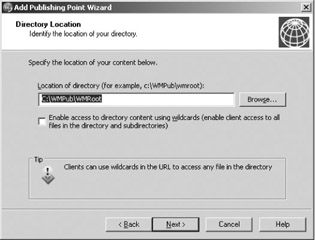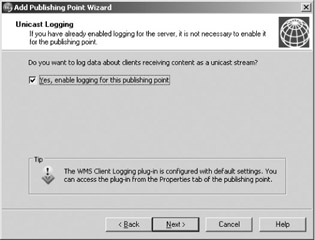Configuring Publishing Points
We introduced publishing points in chapter 3. Windows Media Services uses publishing points to translate a client request for content into a physical path on the server hosting the content. After a client successfully connects to a publishing point, your Windows Media server manages the connection and streams the content.
Two default publishing points—one for broadcast content and one for on-demand content—are provided during setup. These are preconfigured with sample content, playlists, and program defaults. You can rename these publishing points or save them with a new name to customize the configuration. You can also create new publishing points from scratch by using the publishing point wizards.
When configuring your publishing point, the wizard will ask you to provide the following information:
-
Content source (encoder, file, directory, or playlist) and associated details. Because Coho Winery is streaming files that were encoded from DVD, the Webmaster chooses the directory option as shown in figure 7.11.

Figure 7.11: Provide the name and location of the content source. -
Publishing point name and type (on-demand or broadcast). Coho Winery will stream on-demand content only and is creating a single publishing point for all content. This is the simplest way to set up the structure and is easy to maintain. All of the content for the publishing point will be stored in the same directory. WMPub\WMRoot is the default directory for content in Windows Media Services. If the streaming media site is successful, and the winery team decides to add more videos, they will revisit the directory structure. At that time, they may decide to create separate directories for different kinds of content, such as audio-only content, high-bit-rate content, or some other differentiating factor. Having separate directories in this way makes for easier maintenance and administration, but is not necessary at this early stage.
The name that the Coho Winery Webmaster assigns to the publishing point is related to the content that will be streamed, as shown in figure 7.12.

Figure 7.12: Provide a publishing point name that describes the content. -
Distribution method (unicast or multicast). When streaming on-demand content, unicast delivery is the only distribution method available, and the choice is made automatically. If the Coho Winery were to stream live content, the Webmaster would have to choose between unicast and multicast delivery. However, since they stream to clients over the Internet, and because most Internet networks don’t yet support multicast distribution, any live Coho Winery content would also be streamed using unicast delivery.
-
Logging preference. As mentioned earlier, the Coho Winery team does want to collect and review client connection and usage data. When the Web-master selects the client logging option (see figure 7.13), the WMS Client Logging plug-in is enabled for them so no further configuration of the plug-in is required (unless she wants to change the log location, change the log cycle, or make other adjustments).

Figure 7.13: Enabling the client logging feature.
EAN: 2147483647
Pages: 258